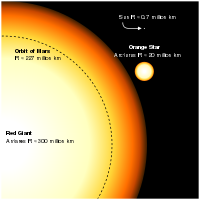Antares
Antares is the name of the star α Scorpii (α Sco / 21 Sco), the brightest in the constellation of Scorpio with apparent magnitude +1.09 and the sixteenth brightest in the night sky. Along with Aldebaran (α Tauri), Espiga (α Virginis) and Regulus (α Leonis) it is among the four brightest stars near the ecliptic.
Antares in ancient times
The name Antares comes from the Greek anti Ares (Άντάρης) and means "the rival of Ares" or "the opposite of Ares" due to its reddish color, since in the night sky it rivaled the planet Mars (Ἄρης, Ares in Greek) which passes very close to this star every 1 year and 11 months. Its distinctive reddish color has made it an object of interest in many societies of the past.
The location of the star in the center of the constellation of Scorpius explains its other name, of Arabic origin, Kalb al Akrab ("the heart of the scorpion"). In Egyptian astronomy, she represented the goddess Serket or Selkit, announcing the sunrise through her temples on the autumnal equinox (3700-3500 BC); Many of the Egyptian temples are oriented in such a way that the light from Antares played an important role in the ceremonies that took place. In ancient Persia it was one of the four "Royal Stars" and probably the Guardian of Heaven mentioned as Satevis; the Corasmians called it Dharind, "the grasper", and the Copts Kharthian, "the heart".
The Chinese included Al Niyat (σ Scorpii) and τ Scorpii—on either side of Antares—for their Chinese constellation Sin or Xīn, with Al Niyat being the determining star.
Features
Antares is a red supergiant of class M1.5Iab located approximately 550 light-years from the solar system. It approaches us at a speed of 3.4 km/s: this value is due both to its own motion and to the movement of the Sun around the center of the Milky Way. Its luminosity in the visible spectrum is 10,000 times that of the Sun. It has a surface temperature of "only" 3600 K, so it emits a considerable fraction of its luminosity in the infrared, its bolometric luminosity being 60,000 times greater than the solar luminosity. From its temperature and luminosity, its radius can be estimated at 883 solar radii, equal to 3 AU. If it were in the center of our solar system, its surface would extend between the orbits of Mars and Jupiter, encompassing practically the entire main asteroid belt. And if a photon started from the center of the star, traveling at the speed of light, it would take 24 minutes to reach the surface. Measuring its angular diameter results in an even larger radius of 3.4 AU.
Its mass is estimated to be between 15 and 18 solar masses. This value, together with the fact that it is in the red supergiant stage, indicates that Antares is not far from exploding as a spectacular supernova (which could happen in the next million years), leaving a neutron star as a remnant. or a black hole. Its colossal size compared to its mass results in a very low mean density, much less than that of the Sun. It is also a pulsating semiregular variable from whose surface a stellar wind blows, causing the star to be enveloped in a cloud of gas.
Antares forms a binary system with a bluish-white class B2.5 star, Antares B, visually separated by 3 arc seconds. The separation in space between the two stars is approximately 550 AU and the orbital period can be about 2500 years. The companion is magnitude +5.5 and its luminosity is 1/370th that of its bright companion, despite the fact that it is 170 times more luminous than our Sun. It has often been described as green or emerald in color—probably for a contrasting effect—and was discovered by Johann Tobias Bürg in 1819 during a lunar occultation.
Observation
Around May 31 is the best time of year to observe Antares because that's when the star is in opposition to the Sun. At that time Antares rises at sunset and sets at sunrise. In this situation it is visible throughout the night, depending, of course, on the place on Earth where we are. For at least two to three weeks before and after November 30, the star is not visible to the dazzling Sun. This period is longer in the northern hemisphere because the star's declination lies significantly south of the celestial equator.. The star begins to be visible at dawn, a few hours before dawn, during the months of February, March and April, and already at the end of spring it can be seen at nightfall.
A few arc minutes southwest of Antares, the globular cluster M4 can be seen through binoculars as a fluffy snowball; through any amateur telescope it can be resolved into orange giant stars, whose color can be seen in long-exposure photographs.
Contenido relacionado
Redshift
Bread (satellite)
Antichton
